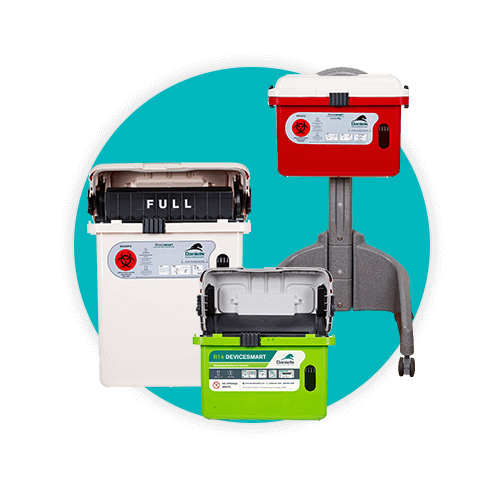Guide to Delaware Medical Waste Regulations

As a healthcare facility, or any facility that produces medical waste, you are aware that you must follow federal guidelines in regard to healthcare waste management. So do Delaware’s medical waste regulations differ from federal guidelines? Who should you follow? Federal guidelines or state guidelines? Both of course!
In fact, state guidelines in regard to healthcare waste management and infectious waste segregation – what is allowed and what isn’t must also be followed to the letter.
Doesn’t that seem redundant? Not really, because in many states throughout the country, state regulations for waste segregation, packaging and labeling numerous types of waste such as biological waste, pathological waste, or chemo waste – just to name a few – are different than other states.
While most state guidelines for medical waste handling, treatment, storage and disposal are similar, some states take things further. Think reusable containers, a focus on long-term sustainability, reducing container related sharps injuries, protecting employees working in medical waste environments (including medical waste disposal company employees), and most importantly, reducing the amount of medical waste heading to local landfills.
If you work in any healthcare capacity in Delaware, know the rules. It’s the only way to stay compliant and reduce the risk of fines, penalties, and damage to your reputation.
Delaware’s medical waste regulations – the basics
Delaware’s medical waste regulations for infectious waste (known as special waste management in their code) are found under Delaware’s Administrative Code (DE Admin Code) 1301.11.3. Not all state regulations are easy to find, nor to understand. Thankfully, Delaware’s governing laws and regulations regarding waste stream definitions, labeling, handling, packaging of infectious or biohazard waste are relatively clear.
In the state of Delaware, Title VII: Natural Resources and Environmental Control is divided into specific categories. One of them is titled Division of Waste and Hazardous Substances. Under that heading are even more specific regulations and subdivisions. One of those is the Solid and Hazardous Waste Management Section. Be patient. Often, when looking for detailed information, you may have to do a little digging. Under the Solid and Hazardous Waste Management Section, you’ll find a number of regulation sections:
- 1301: Regulations governing solid waste
- 1302: Regulations governing hazardous waste
- 1305: Universal recycling regulations
- 1370: Regulations governing the location of hazardous waste storage, treatment, and disposal facilities
When browsing these codes, you’ll find access to specific categories such as those applicable to how a medical waste generator is measured based on volume of medical waste it produces and how it is to be handled:
- Large quantity generators: 7 DE Admin Code 1301.11.17
- Small quantity generators: 7 DE Admin Code 1301.11.5
- Packaging and labeling specifications for infectious waste: 7 DE Admin Code 1301.11.8.1
- Rendering waste noninfectious: 7 DE Admin Code 1301.11.11
Start with definitions
Among other regulations are definitions, which are extremely important for any medical waste generator. Not all definitions of certain types of medical waste or what a state deems medical waste are identical to those of the federal government or other states. You can find definitions for Delaware’s infectious waste under the same codes as above (1301.11.3 and 1301.11.4).
Under the 1302 codes (regulations governing hazardous waste), you’ll find numerous “parts” that provide specific guidelines when it comes to waste segregation and hazardous waste disposal, especially in healthcare waste segregation and waste stream management. Just a few of the topics covered in this administrative code include:
- Part 124: Procedures for decision-making
- Part 261: Identification and listing of hazardous waste
Keep in mind that when searching for specific information, medical waste generators must often bounce back and forth between regulations and sections. For example, under section 261.3 definition of hazardous waste, the state of Delaware specifies that:
“(a)A solid waste, as defined in section 261.2, is a hazardous waste if:
1. It is not excluded from regulation as a hazardous waste under section 261.4 (b); and
2. It meets any of the following criteria…”
[it goes on to list a number of inclusions regarding whether the waste exhibits any characteristics of hazardous waste identified in subpart C of this part]. Got it?
By scrolling down in this document (see above link), you’ll come to Subpart B: Criteria for identifying the characteristics of hazardous waste and for listing hazardous waste. Specifically, this is section 261.10: Criteria for identifying the characteristics of hazardous waste. This regulation states:
“The secretary shall identify and define a characteristic of hazardous waste in subpart C only upon determining that:
1. A solid waste that exhibits a characteristic may:
i. cause, or significantly contribute to an increase in mortality or an increase in serious irreversible, or incapacitating reversible illness; or
ii. Pose a substantial present or potential hazard to human health or the environment when it is improperly treated, stored, transported, disposed of or otherwise managed…”
Phew!
Daniels Health knows it takes a lot of patience, determination, and stamina to wade through hundreds of regulations and content when it comes to administrative codes dealing with medical waste. Details regarding specific instructions for handling and disposal as well as labeling of biohazard waste, chemotherapy waste, clinical waste, and surgical waste are specific, and often difficult to find.
In this regard, Delaware’s medical waste regulations can be as challenging to dive into and understand, but it’s important to take the time to do so – or hire someone who can. It is extremely important for medical waste generators to take a cradle-to-grave approach and seriously consider (and avoid) the ramifications of non-compliance.
As an example, Part 262 (Standards Applicable to Generators of Hazardous Waste) of the Code of Federal Regulations specifies that generators of hazardous waste must follow certain guidelines to determine the applicability of certain standards – depending on the quantity of hazardous waste generated on a monthly basis.
For example, §262.10 (c) states:
“a generator who treats, stores, or disposes of hazardous waste on-site must only comply with the following sections of this part with respect to that waste:
- §262.11 for determining whether or not it is a hazardous waste
- §262.12 for obtaining an EPA identification number
- §262.344 accumulation of hazardous waste
- §262.40 (c) and (d) for record-keeping
- §262.434 additional reporting and if applicable
- §262.70 for farmers.”
Yes, the guidelines, regulations, the laws, and the parts, subparts, and sub-subparts can be confusing, intimidating, and frustrating to go through. Even so, the cradle-to-grave approach maintains that the healthcare or medical waste generator who produces any type of medical waste must be – and is legally responsible – for that waste from its point of origin to its final disposition.
It also means that the responsibility of the medical waste doesn’t end when the medical waste disposal company picks it up. It’s your responsibility to make sure that the waste is properly disposed of based on federal and state regulations.
Let us worry about the details
Attention to detail provide benefits such as maintenance of compliance. Improper waste segregation or medical waste disposal, especially of biohazard waste, can cost a company’s reputation and budget big time. Fines for noncompliance today can often exceed $70,000 per violation, per day that the issue is not corrected.
Daniels Health is dedicated to providing information and guidance for proper healthcare waste management that will keep your company, hospital, or business on the right side of the law. Our long-term, efficient, and sustainable solutions not only reduce the risk of noncompliance issues, but can save your hospital/clinic/dental office/outpatient surgical center tens of thousands of dollars a year on medical waste disposal costs.
For more information on how Daniels Health can help your facility stay on top of ever-changing guidelines and regulations, contact us today. Alternatively find out more about our Delaware operations and service capabilities on our Delaware service page here.
Let's Talk!
Your time is valuable, and we don’t want to play hard to get. You can either phone us directly on the details listed on our contact page, or feel free to fill out this short form and one of our team members will get back to you as quickly as possible.
